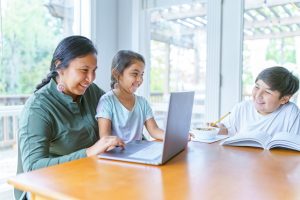The Waterford.org vision is for every child to reach their full potential through accessible and effective early learning experiences that put them on a meaningful path in school and life. We know that children do better in school when their families are involved and that families come in all shapes and sizes. As we step into Pride Month, it’s a great time to think about how you as an educator can create a welcoming school environment that supports all families, including your LGBTQ+ parents/caregivers and their children, which leads to equitable learning experiences for all.
Waterford recommends these two educational frameworks for guiding effective and inclusive family engagement and instruction:
- The CARES framework: This research-backed framework helps cultivate family partnerships through asset-based and transparent communication, respectful and trusting relationships, and personalized support. The unique needs of each community are embraced, active listening is encouraged, and a tailored approach to family engagement is the result.
- The Windows and Mirrors learning framework: This framework fosters belonging through an inclusive curriculum. Children benefit when they receive both stories that offer a “window” into the experiences of others and stories that “mirror” their own.
This dual approach ensures that all children feel seen and valued while offering opportunities to build empathy and develop an understanding of others.
As a school leader, you have the power to create a safe and equitable learning space that encourages the active participation of all families, including LGBTQ+ ones. Delve into these strategies rooted in the CARES and Windows and Mirrors frameworks and discover how you can support families in your school community.
Understanding and Embracing Diverse Family Structures
Recognizing and celebrating diverse family structures is crucial to ensuring every child reaches their full potential. When children see their own families reflected in their learning environment, they feel seen, valued, and included. This recognition enhances their educational experience and contributes to their personal growth.

According to research, most American households do not follow the traditional nuclear family structure. A 2022 survey found that 82.2% of American households do not fit this model. Here are some examples of diverse family structures:
- Nuclear Families: A family with two parents of opposite gender and their children.
- Single-Parent Families: One parent raising one or more children.
- Blended Families: Parents with children from previous relationships who come together to form a new family unit.
- Extended Families: Families that include caregivers such as grandparents, aunts, uncles, and cousins living together or nearby.
- Foster and Adoptive Families: Families that include children who are fostered or have been adopted.
- Multicultural and Multiracial Families: Members of the family can come from different cultural, ethnic, and racial backgrounds.
- Same-Sex Parent Families: Families with two parents of the same gender and their children.
- Gender-Nonconforming Families: Members of this family can identify as transgender or gender-nonconforming.
To understand and embrace these diverse family structures, it’s important to recognize and challenge implicit bias. Implicit biases are subconscious assumptions, such as what a family should look like. Whoever believes such biases can be unintentionally influenced to exclude families that don’t fit those assumptions. Being aware of these biases is the first step towards changing our understanding and creating an inclusive environment. Consider reflecting on these questions to identify and address potential biases:
- Do I make assumptions about family structures based on appearances or names?
- Are my communications and classroom materials inclusive of all family types?
Use Inclusive Language and Mindful Communication with Caregivers
Subtle language choices can make a big difference in making all families feel welcome. Instead of using terms like “Mom and Dad” on forms and in communications, use more inclusive terms like “caregivers” or “guardians.”
You can also consider allowing a blank space so families can self-identify their roles and relationships. Here are some questions from the National Center on Parent, Family, and Community Engagement to guide your conversations:
- What name does your child call you?
- How would you like us to refer to you when talking with your child?
- How would you like me to describe your family to others (other children/other adults)?
- How would you like me to respond to questions about your family?
By incorporating these practices, you can create a more welcoming and supportive environment that recognizes and values the uniqueness of every family, ultimately helping each child to thrive.
Incorporate Stories and Activities that Include Diverse Perspectives
Including stories and activities that reflect diverse experiences in your curriculum ensures that all students see their families represented. Here are three books you can incorporate into your school or classroom library or your next reading lesson to promote inclusion of LGBTQ+ families:
 The Family Book by Todd Parr
The Family Book by Todd Parr
Every family is unique and worth celebrating. This picture book encourages children to discuss the many different kinds of families there are, like adopted families, step-families, and families with two moms or two dads.
Plenty of Hugs by Fran Manushkin
This rhyming book follows a boy and his two moms as they spend a day together. Follow along as they go on a bike ride, visit a zoo, and prepare for bedtime.
Families, Families, Families! by Suzanne Lang
Moms, dads, sisters, brothers — and even Great Aunt Sue — appear in dozens of combinations, demonstrating all kinds of nontraditional families. Silly animals are cleverly depicted in framed portraits as a warm celebration of family love.
Foster Meaningful Family Partnerships
Building strong family partnerships is key to enriching learning experiences and improving student outcomes. Here are ways you can build and nurture these partnerships with LGBTQ+ caregivers:
- Create a Culture of Transparent and Respectful Communication: Start by asking families, “What does effective support look like to you?” Allow them to voice their preferences and provide feedback. Anonymous surveys can help cultivate transparent communication lines.
- Facilitate Family Networking and Resource Sharing: Connect caregivers with other families and community resources. This could involve coordinating support groups or providing information on supporting their child’s learning at home.
- Plan Inclusive Events: Host events celebrating diverse cultures and family structures, such as a multicultural night or a Pride Month celebration.
This June and beyond, we can commit to creating welcoming school communities that reflect and support the diverse family structures and lived experiences of all students.
Want to learn more about inclusive family engagement? Check out this ebook to explore the CARES framework and discover our extensive family engagement resources.

